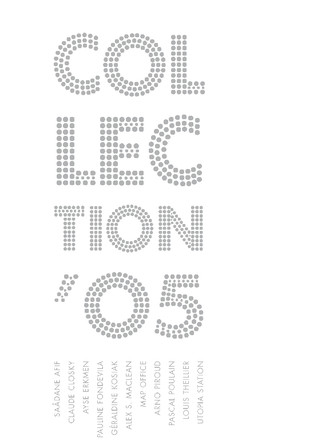From photography to sculpture, the points of view embodied in the works that refer to urbanism and architecture are largely influenced by the cultural specificities of the places where the artists live. Alex MacLean interprets America through his views of the sky in "industrial" zones of residence, consumption and production. Map Office, a duo of architects working in Hong Kong, looks at the disorderly nature of urbanism in Asia in the post-industrial age, with, for example, a 60-kilometre strip beside a motorway in Guangzhou, occupied by a large temporary market with a highly chaotic identity. As for Pascal Poulain, he shows how urban spaces have been "infantilised" by hypertrophic design and gimmicky constructional options.
It is with sculptural works that Saâdane Afif and Louis Theillier portray imaginary architectural renovation. Afif took over the former factory that now houses the Creux de l'Enfer art centre in Thiers, reconfiguring its relationship with the waterfall in the Durolle river beside which it was built. Theillier's Réhabilitation, poised between abstract sculpture and the experimental architectural model, takes the form of folded photographs of buildings that oscillate between the improbable and the utopian.
Claude Closky and Ayse Erkmen demonstrate the excesses of the mass circulation of images. Journal (2005) by Closky, the winner of the 2005 Prix Marcel Duchamp, is made up of multiple screens on which news items taken from the Internet are shown at an accelerating pace, accompanied by onomatopoeic sounds. Erkmen's Scenic Overlook (2005) shows a procession of idyllic landscapes taken from a catalogue aimed at advertising executives, showing how such cliches, which are universal and without territoriality, are also devoid of sense : what is being sold is "ready-to-wear" dreams. Faced with a world saturated in images and signs, Arno Piroud puts forward (and not without humour-tinged irony) out-of-sync setups that can wrong-foot our certainties. Enter your Dreams (2005), for example, suggests a way to avoid prefabricated dreams.
The drawings of Géraldine Kosiak and Pauline Fondevila are expressions, in very different modes, of their respective personal universes. Kosiak depicts the world of her childhood and memories. In Catalogues (2004) she examines a broad diversity of objects and beings over time, in the form of plates that bring to mind a mail-order catalogue, or one of Georges Perec's books. Fondevila sets forth her "personal mythologies", which are woven out of intellectual references (literature, philosophy, essays), artistic allusions and popular culture (films, songs). The result is a revelation of worlds in which the everyday and the imaginary coalesce.
Finally, there is a series of posters by Utopia Station, representing a part of the pluridisciplinary project initiated by the exhibition curators, Molly Nesbit and Hans-Ulrich Obrist, and the artist Rirkrit Tiravanija, at the 2003 Venice biennial. Utopia is rethought in terms of a platform for exchanges, with "stopping places" whose number keeps on growing as Utopia Station engages in more and more collaborations around the world, with artists, architects, writers, actors, performers, etc.


